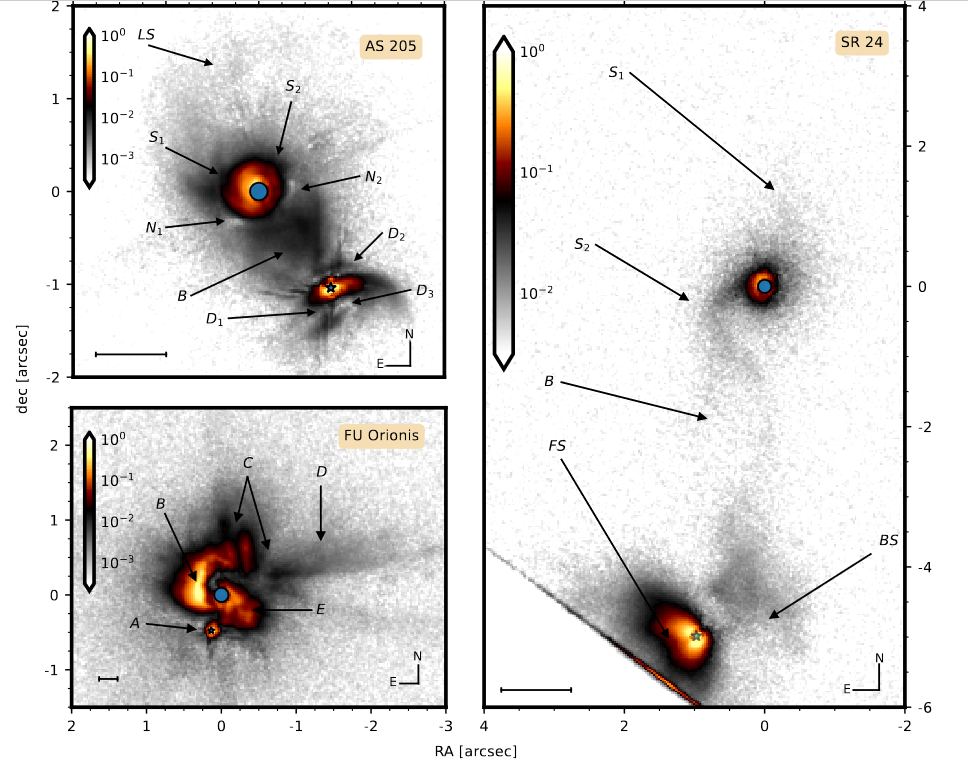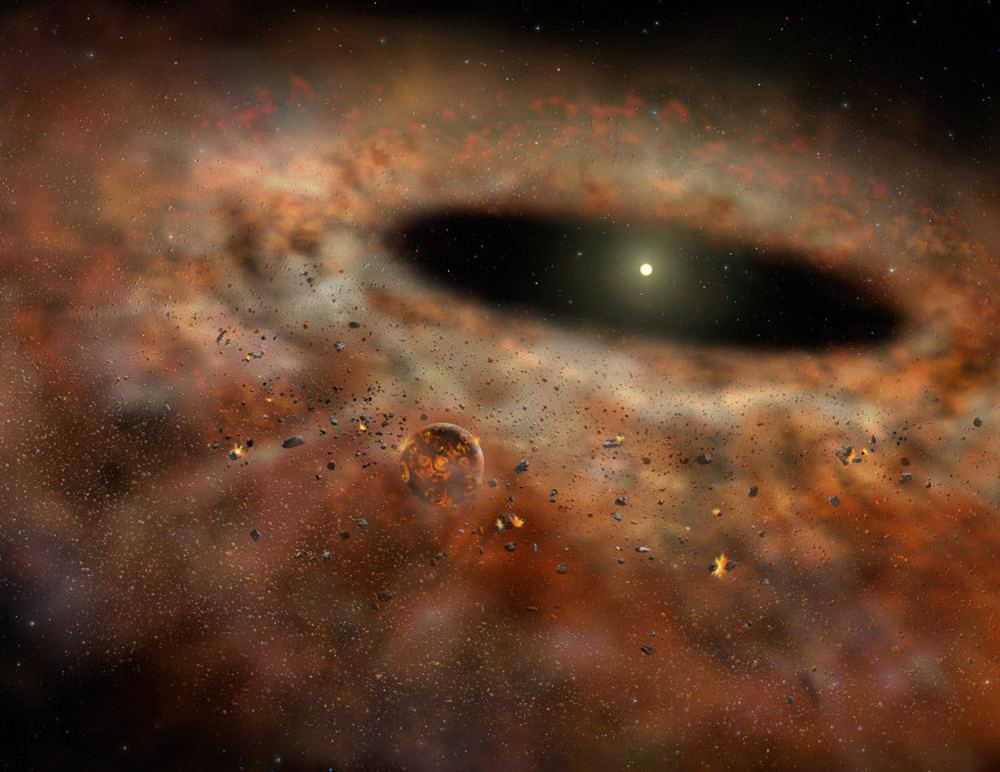According to the most widely-accepted theory about star formation (Nebular Hypothesis), stars and planets form from huge clouds of dust and gas. These clouds undergo gravitational collapse at their center, leading to the birth of new stars, while the rest of the material forms disks around it. Over time, these disks become ring structures that accrete to form systems of planets, planetoids, asteroid belts, and Kuiper belts. For some time, astronomers have questioned how interactions between early stellar environments may affect their formation and evolution.
For instance, it has been theorized that gravitational interactions with a passing star or shock waves from a supernova might have triggered the core collapse that led to our Sun. To investigate this possibility, an international team of astronomers observed three interacting twin disc systems using the Spectro-Polarimetric High-contrast Exoplanet REsearch (SPHERE) on the ESO’s Very Large Telescope (VLT). Their findings show that due to their dense stellar environments, gravitational encounters between early-stage star systems play a significant role in their evolution.
The research team consisted of astronomers from the European Southern Observatory (ESO), the Space Telescope Science Institute (STScI), the Millennium Nucleus on Young Exoplanets and their Moons (YEMS), the Center for Interdisciplinary Research in Astrophysics and Space Exploration (CIRAS), the Institute for Particle Physics and Astrophysics at ETH Zurich, the Max-Planck-Institute for Astronomy (MPIA), the Mullard Space Science Laboratory, the Kavli Institute for Astrophysics and Space Research, and multiple universities.
The classical idea of star formation states that stars form individually from a spherically-symmetric and isolated prestellar core. This has come into question in recent years as astronomers have made more observations that don’t fit with this model. For one, astronomers have observed newborn stars embedded in thin filaments within molecular clouds, suggesting that large-scale processes are at work in these dynamical environments. In addition, surveys of star-forming regions have found that a statistically-significant fraction of prestellar cores leads to the formation of multiple systems rather than just one.
This is believed to have been the case with our Sun, which formed from the same nebula as several “solar siblings” that were then dispersed throughout the Milky Way. These lines of evidence all point toward interactions between early systems, and the effect this has on their evolution is not yet well-constrained. But by examining early star systems and the protoplanetary disks that orbit them, astronomers can observe the gravitational perturbations these interactions would cause. As they indicate in their paper, stellar interaction may occur in three ways.
These include non-recurring, hyperbolic, or parabolic passages (aka. “fly-bys”), through the co-evolution of binary stars, or through one star capturing another (aka. binary capture). To test their predictions, the team analyzed three interacting twin-disc systems (AS 205, EM* SR 24, and FU Orionis) using the Infra-Red Dual Imaging and Spectrograph (IRDIS) on the VLT’s SPHERE instrument. This cryogenic camera allows SPHERE to conduct dual polarized light observations of AS 205, EM* SR 24, and FU Orionis in the 0.95 – 2.32 ?m near-infrared (NIR) band.
All were previously observed by instruments like the Atacama Large Millimeter-submillimeter Array (ALMA) and the VLT’s NaCo Nasmyth Adaptive Optics System Near-Infrared Imager and Spectrograph (NAOS-CONICA, or NACO) instrument. These observations confirmed that these binary stars are twin disk systems, where both the primary and companion stars have confirmed protoplanetary disks. They also compared their polarized light observations with similar-resolution data sets (ALMA and gas emission data) to place tighter constraints on the geometry and content of each system.

By examining how light from these stars was scattered by their disks, the team discerned spiral patterns that were likely caused by gravitational interaction and connecting filaments between the stars. From this, they were able to predict what types of interactions have taken place between the binary companions and their respective disks. As they stated:
“The overall structure observed in AS 205 is consistent with a hyperbolic stellar fly-by as [the] dynamical origin. The clockwise direction of the spirals S1 and S2 around AS 205N suggests a counter-clockwise fly-by and that the periastron of the orbit (location of closest approach) has already been crossed.”
“The northern disc constitutes a circumbinary disc around the components SR 24Na and SR 24Nb. Also, the northern disc displays [a] strong asymmetrical structure with the presence of extended scattering north-west of the stars (?1), tracing a spiral arm that opens in [a] counter-clockwise direction and is opposed by a spiral arm to the south-west of SR 24N (?2). The southern spiral arm smoothly merges into the bridge towards SR 24S.”
“The scattered light [of FU Orionis] shows strongly disturbed structures such as the bright extended arm east of the northern source, possibly linked to gravitational interaction and a subsequent stellar outburst. The kinematics of the arm (?) link it to both the systematic velocity of the northern and southern source, further promoting the idea that it results from a recent close stellar encounter.”
The authors also acknowledge that possible dynamical scenarios could explain the spiral perturbations they observed, such as “coupled binary formation from a common molecular cloud of high angular momentum.” They also note that there are uncertainties in their analysis as it does not take systemic error into account and that their results should not be considered definitive. However, this presents an opportunity for follow-up observations and future surveys to further constrain the geometry of these systems and test these results.
These surveys will benefit from next-generation instruments like the James Webb Space Telescope (JWST) that are optimized for studying objects in the near- and mid-infrared spectrum. Ground-based observatories like the Extremely Large Telescope (ELT) will be able to directly image these systems using a combination of coronographs, spectrometers, and adaptive optics. These surveys will reveal a great deal about young star systems and the formation and evolution of planetary systems.
Further Reading: arXiv

